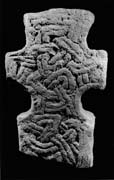Select a site alphabetically from the choices shown in the box below. Alternatively, browse sculptural examples using the Forward/Back buttons.
Chapters for this volume, along with copies of original in-text images, are available here.
Object type: Cross-head and part of -shaft
Measurements: H. 67.5 cm (26.6 in); W. (shaft): 31 cm (12.25 in) (head): 42.5 cm (16.75 in); D. 14.5 cm (5.75 in)
Stone type: Medium-grained, pale yellow (2.5Y 7/4) sandstone; deltaic channel sandstone, Saltwick Formation, Aalenian, Middle Jurassic, probably from North Yorkshire Moors
Plate numbers in printed volume: 666-669
Corpus volume reference: Vol 3 p. 180-181
(There may be more views or larger images available for this item. Click on the thumbnail image to view.)
Free-armed cross-head, type B10, with the top of the shaft also surviving.
A (broad): The shaft and perimeter have a flat edge moulding. The face of the shaft is covered with irregular interlace, including a pattern A loop at the top of the shaft and, above it, a pattern C loop. The strands are broad and median-incised, and roughly cut with a punch. They continue from the shaft into the cross-head without interruption. In the upper limb of the cross it ends in a bar terminal.
B (narrow): Scabbled. On the end of the arm and the top of the shaft are faint traces of interlace with broad, median-incised strands.
C (broad): Very badly weathered: in fact, hollowed.
D (narrow): Very weathered, but there are remains of interlace or straight line pattern with broad, median-incised, strands on the end of the arm and the top of the shaft.
This is a rustic piece and must have been imported into this area where freestone is scarce. The bold interlace is reminiscent of the stopped-plait of the Helmsley hogback (no. 1). The continuity of the shaft and cross in ornamental terms is found on Hovingham 2 and North Frodingham 1 in a more accomplished manner.



